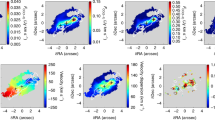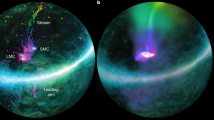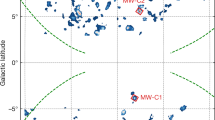Abstract
The Orion Bar is the archetypal edge-on molecular cloud surface illuminated by strong ultraviolet radiation from nearby massive stars. Our relative closeness to the Orion nebula (about 1,350 light years away from Earth) means that we can study the effects of stellar feedback on the parental cloud in detail. Visible-light observations of the Orion Bar1 show that the transition between the hot ionized gas and the warm neutral atomic gas (the ionization front) is spatially well separated from the transition between atomic and molecular gas (the dissociation front), by about 15 arcseconds or 6,200 astronomical units (one astronomical unit is the Earth–Sun distance). Static equilibrium models2,3 used to interpret previous far-infrared and radio observations of the neutral gas in the Orion Bar4,5,6 (typically at 10–20 arcsecond resolution) predict an inhomogeneous cloud structure comprised of dense clumps embedded in a lower-density extended gas component. Here we report one-arcsecond-resolution millimetre-wave images that allow us to resolve the molecular cloud surface. In contrast to stationary model predictions7,8,9, there is no appreciable offset between the peak of the H2 vibrational emission (delineating the H/H2 transition) and the edge of the observed CO and HCO+ emission. This implies that the H/H2 and C+/C/CO transition zones are very close. We find a fragmented ridge of high-density substructures, photoablative gas flows and instabilities at the molecular cloud surface. The results suggest that the cloud edge has been compressed by a high-pressure wave that is moving into the molecular cloud, demonstrating that dynamical and non-equilibrium effects are important for the cloud evolution.
This is a preview of subscription content, access via your institution
Access options
Subscribe to this journal
Receive 51 print issues and online access
$199.00 per year
only $3.90 per issue
Buy this article
- Purchase on Springer Link
- Instant access to full article PDF
Prices may be subject to local taxes which are calculated during checkout


Similar content being viewed by others
References
Walmsley, C. M., Natta, A., Oliva, E. & Testi, L. The structure of the Orion Bar. Astron. Astrophys. 364, 301–317 (2000)
Tielens, A. G. G. M. & Hollenbach, D. J. Photodissociation regions. I: basic model. Astrophys. J. 291, 722–754 (1985)
Andree-Labsch, S., Ossenkopf, V. & Röllig, M. 3D modelling of clumpy PDRs: understanding the Orion Bar stratification. Preprint at http://arxiv.org/abs/1405.5553 (2014)
Tielens, A. G. G. M. et al. Anatomy of the photodissociation region in the Orion Bar. Science 262, 86–89 (1993)
Hogerheijde, M. R., Jansen, D. J. & van Dishoeck, E. F. Millimeter and submillimeter observations of the Orion Bar. 1: physical structure. Astron. Astrophys. 294, 792–810 (1995)
Young Owl, R. C., Meixner, M. M., Wolfire, M., Tielens, A. G. G. M. & Tauber, J. HCN and HCO+ images of the Orion Bar photodissociation region. Astrophys. J. 540, 886–906 (2000)
Sternberg, A. & Dalgarno, A. Chemistry in dense photon-dominated regions. Astrophys. J. Suppl. Ser. 99, 565–607 (1995)
Le Petit, F., Nehmé, C., Le Bourlot, J. & Roueff, E. A model for atomic and molecular interstellar gas: The Meudon PDR code. Astrophys. J. Suppl. Ser. 164, 506–529 (2006)
Röllig, M. et al. A photon dominated region code comparison study. Astron. Astrophys. 467, 187–206 (2007)
Genzel, R. & Stutzki, J. The Orion molecular cloud and star-forming region. Annu. Rev. Astron. Astrophys. 27, 41–85 (1989)
Goicoechea, J. R. et al. Velocity-resolved [Cii] emission and [Cii]/FIR mapping along Orion with Herschel. Astrophys. J. 812, 75 (2015)
O’Dell, C. R. The Orion Nebula and its associated population. Annu. Rev. Astron. Astrophys. 39, 99–136 (2001)
van der Werf, P. P. Goss, W. M. & O’Dell, C. R. Tearing the veil: interaction of the Orion Nebula with its neutral environment. Astrophys. J. 762, 101 (2013)
Hollenbach, D. J. & Tielens, A. G. G. M. Photodissociation regions in the interstellar medium of galaxies. Rev. Mod. Phys. 71, 173–230 (1999)
Weilbacher, P. M. et al. A MUSE map of the central Orion Nebula (M 42). Astron. Astrophys. 582, A114 (2015)
Draine, B. T. Physics of the Interstellar and Intergalactic Medium (Princeton Univ. Press, 2011)
Bertoldi, F. & Draine, B. T. Nonequilibrium photodissociation regions: ionization-dissociation fronts. Astrophys. J. 458, 222–232 (1996)
Störzer, H. & Hollenbach, D. J. Nonequilibrium photodissociation regions with advancing ionization fronts. Astrophys. J. 495, 853–870 (1998)
Lis, D. C. & Schilke, P. Dense molecular clumps in the Orion Bar photon-dominated region. Astrophys. J. 597, L145–L148 (2003)
Spitzer, L. Physical Processes in the Interstellar Medium (Wiley, 1978)
Hill, J. K. & Hollenbach, D. J. Effects of expanding compact H ii regions upon molecular clouds: molecular dissociation waves, shock waves, and carbon ionization. Astrophys. J. 225, 390–404 (1978)
Hosokawa, T. & Inutsuka, S.-i. Dynamical expansion of ionization and dissociation front around a massive star. II: on the generality of triggered star formation. Astrophys. J. 646, 240–257 (2006)
Hennebelle, P. & Falgarone, E. Turbulent molecular clouds. Astron. Astrophys. Rev. 20, 55 (2012)
Federrath, C. & Klessen, R. S. On the star formation efficiency of turbulent magnetized clouds. Astrophys. J. 763, 51 (2013)
Tremblin, P., Audit, E., Minier, V., Schmidt, W. & Schneider, N. Three-dimensional simulations of globule and pillar formation around H ii regions: turbulence and shock curvature. Astron. Astrophys. 546, A33 (2012)
Gorti, U. & Hollenbach, D. J. Photoevaporation of clumps in photodissociation regions. Astrophys. J. 573, 215–237 (2002)
Elmegreen, B. G. & Lada, C. J. Sequential formation of subgroups in OB associations. Astrophys. J. 214, 725–741 (1977)
Berné, O., Marcelino, N. & Cernicharo, J. Waves on the surface of the Orion molecular cloud. Nature 466, 947–949 (2010)
García-Segura, G. & Franco, J. From ultracompact to extended H ii regions. Astrophys. J. 469, 171–188 (1996)
Lefloch, B. & Lazareff, B. Cometary globules. 1: formation, evolution and morphology. Astron. Astrophys. 289, 559–578 (1994)
Pety, J. & Rodríguez-Fernández, N. J. Revisiting the theory of interferometric wide-field synthesis. Astron. Astrophys. 517, A12 (2010)
van der Werf, P. P., Stutzki, J., Sternberg, A. & Krabbe, A. Structure and chemistry of the Orion bar photon-dominated region. Astron. Astrophys. 313, 633–648 (1996)
Allers, K. N., Jaffe, D. T., Lacy, J. H., Draine, B. T. & Richter, M. J. H2 pure rotational lines in the Orion Bar. Astrophys. J. 630, 368–380 (2005)
O’Dell, C. R. & Yusef-Zadeh, F. High angular resolution determination of extinction in the Orion Nebula. Astron. J. 120, 382–392 (2000)
Cardelli, J. A., Clayton, G. C. & Mathis, J. S. The relationship between infrared, optical, and ultraviolet extinction. Astrophys. J. 345, 245–256 (1989)
Goicoechea, J. R. et al. Low sulfur depletion in the Horsehead PDR. Astron. Astrophys. 456, 565–580 (2006)
Arab, H. et al. Evolution of dust in the Orion Bar with Herschel. I: radiative transfer modelling. Astron. Astrophys. 541, A19 (2012)
Cuadrado, S. et al. The chemistry and spatial distribution of small hydrocarbons in UV-irradiated molecular clouds: the Orion Bar PDR. Astron. Astrophys. 575, A82 (2015)
Langer, W. D. & Penzias, A. A. 12C/13C isotope ratio across the Galaxy from observations of 13C18O in molecular clouds. Astrophys. J. 357, 477–492 (1990)
Inutsuka, S.-i. & Miyama, S. M. A production mechanism for clusters of dense cores. Astrophys. J. 480, 681–693 (1997)
Noel, B., Joblin, C., Maillard, J. P. & Paumard, T. New results on the massive star-forming region S106 by BEAR spectro-imagery. Astron. Astrophys. 436, 569–584 (2005)
Burton, M. G., Hollenbach, D. J. & Tielens, A. G. G. M. Line emission from clumpy photodissociation regions. Astrophys. J. 365, 620–639 (1990)
Wyrowski, F., Schilke, P., Hofner, P. & Walmsley, C. M. Carbon radio recombination lines in the Orion Bar. Astrophys. J. 487, L171–L174 (1997)
Tremblin, P. et al. Ionization compression impact on dense gas distribution and star formation. Probability density functions around HII regions as seen by Herschel. Astron. Astrophys. 564, A106 (2014)
Brogan, C. L., Troland, T. H., Abel, N. P., Goss, W.M. & Crutcher, R. M. in Astronomical Polarimetry: Current Status and Future Directions (eds Adamson, A . et al.) 183–184 (ASP Conference Series 343, Astronomical Society of the Pacific, 2005)
Planck Collaboration. Planck intermediate results. XXXIV: The magnetic field structure in the Rosette Nebula. Astron. Astrophys. 586, A137 (2016)
Roberge, W. G. & Draine, B. T. A new class of solutions for interstellar magnetohydrodynamic shock waves. Astrophys. J. 350, 700–721 (1990)
Raga, A. C., Cantó, J. & Rodríguez, L. F. Analytic and numerical models for the expansion of a compact HII region. Mon. Not. R. Astron. Soc. 419, L39–L43 (2012)
Hollenbach, D. J. & Natta, A. Time-dependent photodissociation regions. Astrophys. J. 455, 133–144 (1995)
Bertoldi, F. ISO: A Novel Look at the Photodissociated Surfaces of Molecular Clouds 67–72 (Special Publication 419, European Space Agency, 1997)
Neufeld, D. A. & Wolfire, M. G. The chemistry of interstellar molecules containing the halogen elements. Astrophys. J. 706, 1594–1604 (2009)
Neufeld, D. A. et al. Discovery of interstellar CF+. Astron. Astrophys. 454, L37–L40 (2006)
Guzmán, V. et al. The IRAM-30m line survey of the Horsehead PDR. I: CF+ as a tracer of C+ and as a measure of the fluorine abundance. Astron. Astrophys. 543, L1 (2012)
Agúndez, M., Goicoechea, J. R., Cernicharo, J., Faure, A. & Roueff, E. The chemistry of vibrationally excited H2 in the interstellar medium. Astrophys. J. 713, 662–670 (2010)
Nagy, Z. et al. The chemistry of ions in the Orion Bar. I. CH+, SH+, and CF+: the effect of high electron density and vibrationally excited H2 in a warm PDR surface. Astron. Astrophys. 550, A96 (2013)
Goicoechea, J. R. et al. OH emission from warm and dense gas in the Orion Bar PDR. Astron. Astrophys. 530, L16 (2011)
Stoerzer, H., Stutzki, J. & Sternberg, A. CO+ in the Orion Bar, M17 and S140 star-forming regions. Astron. Astrophys. 296, L9–L12 (1995)
Acknowledgements
We thank the ERC for support under grant ERC-2013-Syg-610256-NANOCOSMOS. We also thank MINECO, Spain, for funding support under grants CSD2009-00038 and AYA2012-32032. This work was in part supported by the French CNRS programme ‘Physique et Chimie du Milieu Interstellaire’. We thank P. Schilke and D. Lis for sharing their IRAM-PdBI observations of the H13CN J = 1–0 condensations inside the Orion Bar, and M. Walmsley for sharing his H2 v = 1–0 S(1) and O i 1.3 μm infrared images. ALMA is a partnership of the ESO (representing its member states), the NSF (USA) and NINS (Japan), together with the NRC (Canada), the NSC and ASIAA (Taiwan) and KASI (Republic of Korea) in cooperation with the Republic of Chile. The Joint ALMA Observatory is operated by the ESO, the AUI/NRAO and the NAOJ. This Letter makes use of observations obtained with the IRAM 30 m telescope. IRAM is supported by the INSU/CNRS (France), the MPG (Germany), and the IGN (Spain).
Author information
Authors and Affiliations
Contributions
J.R.G. was the principal investigator of the ALMA project. He led the scientific analysis, modelling and wrote the manuscript. J.P. and E.C. carried out the ALMA data calibration and data reduction. S.C. and N.M. carried out the single-dish maps observations with the IRAM 30 m telescope. All authors participated in the discussion of results, determination of the conclusions and revision of the manuscript.
Corresponding author
Additional information
We used the ALMA data ADS/JAO.ALMA#2012.1.00352.S available at https://almascience.eso.org/aq/?project_code=2012.1.00352.S.
Reviewer Information Nature thanks R. Plume and the other anonymous reviewer(s) for their contribution to the peer review of this work.
Extended data figures and tables
Extended Data Figure 1 Structure of a strongly ultraviolet-irradiated molecular cloud edge.
The incident stellar ultraviolet radiation comes from the left. The velocity of the advancing ionization and dissociation fronts are represented by vIF and vDF respectively. In the Orion Bar, the dissociation front is at about 15″ (about 0.03 pc) from the ionization front. UV, ultraviolet; PAH, polycyclic aromatic hydrocarbons. The snow line refers to the inner cloud layers where molecular gases start to freeze and dust grains become coated by ices.
Extended Data Figure 2 Comparison with other tracers.
a, ALMA HCO+ J = 4–3 line integrated intensity. b, ALMA CO J = 3–2 line peak (Orion Bar velocity component). The red contours represent the H13CN J = 1–0 emission (from 0.08 to 0.026 in steps of 0.02 Jy beam−1 km s−1) of dense condensations inside the Orion Bar19. The black contours show the brightest regions of H2 v = 1–0 S(1) emission1 (from 1.5 to 4.5 in steps of 0.5·10−4 erg s−1 cm−2 sr−1). The H2 image is saturated between δx = 19″ and 23″ (that is, no data are shown). Figures have been rotated 127.5° anticlockwise to bring the incident ultraviolet radiation from the left.
Extended Data Figure 3 Excitation models for different gas temperatures and densities.
a, CO J = 3–2 line peak (for N(CO) = 1018 cm−2). b–d, HCO+ J = 4–3 integrated line intensity at 100 K (b), 200 K (c) and 300 K (d). Each curve represents a different electron abundance model: xe = 0 (blue) and xe = 10−4 (red). Continuous curves are for N(HCO+) = 5 × 1013 cm−2 and dotted lines for N(HCO+) = 2 × 1014 cm−2 (appropriate for deeper inside the Orion Bar, δx > 30″). The horizontal green dashed line represents the average  (a) and
(a) and  (b–d) with their standard deviation (grey shaded) towards the dissociation front (at δx ≈ 15″).
(b–d) with their standard deviation (grey shaded) towards the dissociation front (at δx ≈ 15″).
Extended Data Figure 4 Line velocity centroid, dispersion and profiles.
a, Vertically averaged cuts perpendicular to the Orion Bar in the HCO+ J = 4–3 line velocity centroid (magenta curve) and FWHM velocity dispersion (grey curve). b, CO and HCO+ spectra at representative positions. The top and middle plots show positions between the ionization and dissociation fronts, the bottom plot is inside the molecular Orion Bar. Offsets are given with respect to the rotated images in Extended Data Fig. 2. The velocity of the background cloud is vLSR ≈ 8.5 km s−1 (black dashed line), whereas the velocity of the Orion Bar is vLSR ≈ 11 km s−1 (green line).
PowerPoint slides
Rights and permissions
About this article
Cite this article
Goicoechea, J., Pety, J., Cuadrado, S. et al. Compression and ablation of the photo-irradiated molecular cloud the Orion Bar. Nature 537, 207–209 (2016). https://doi.org/10.1038/nature18957
Received:
Accepted:
Published:
Issue Date:
DOI: https://doi.org/10.1038/nature18957
This article is cited by
-
Violent emissions of newborn stars
Nature (2016)
Comments
By submitting a comment you agree to abide by our Terms and Community Guidelines. If you find something abusive or that does not comply with our terms or guidelines please flag it as inappropriate.



